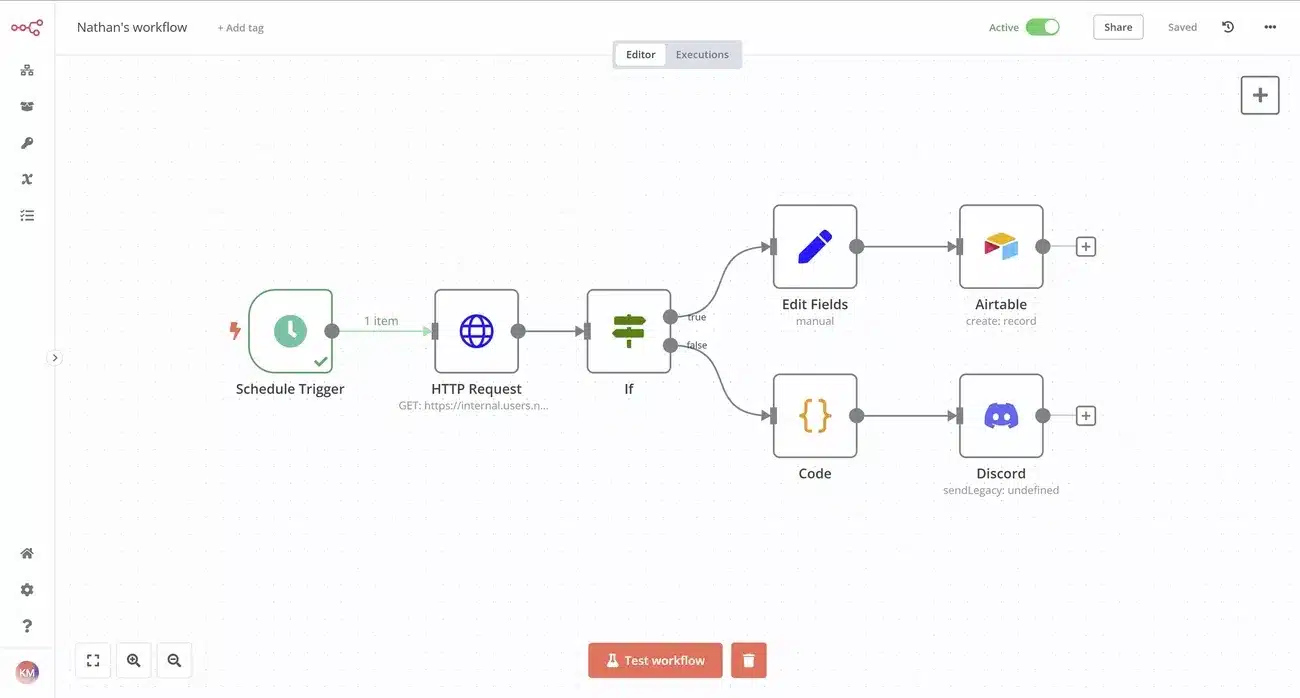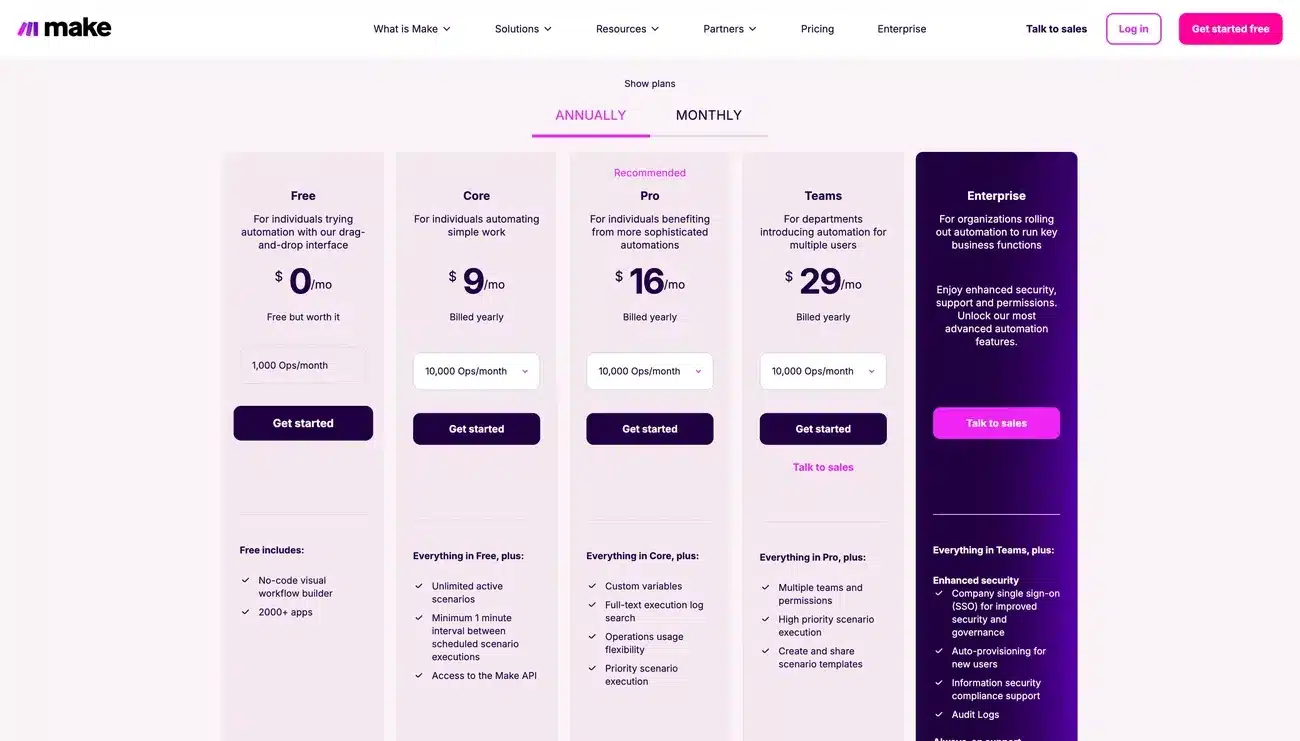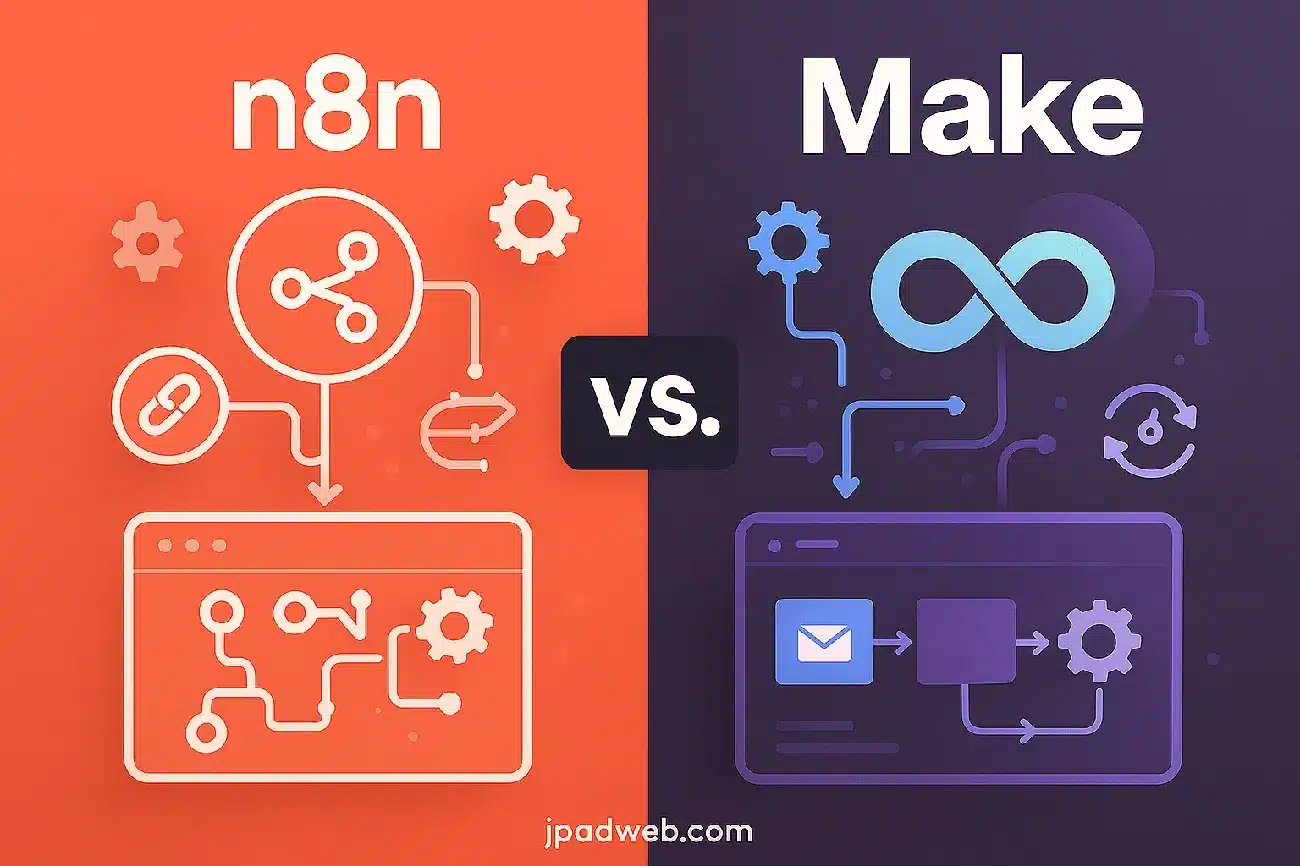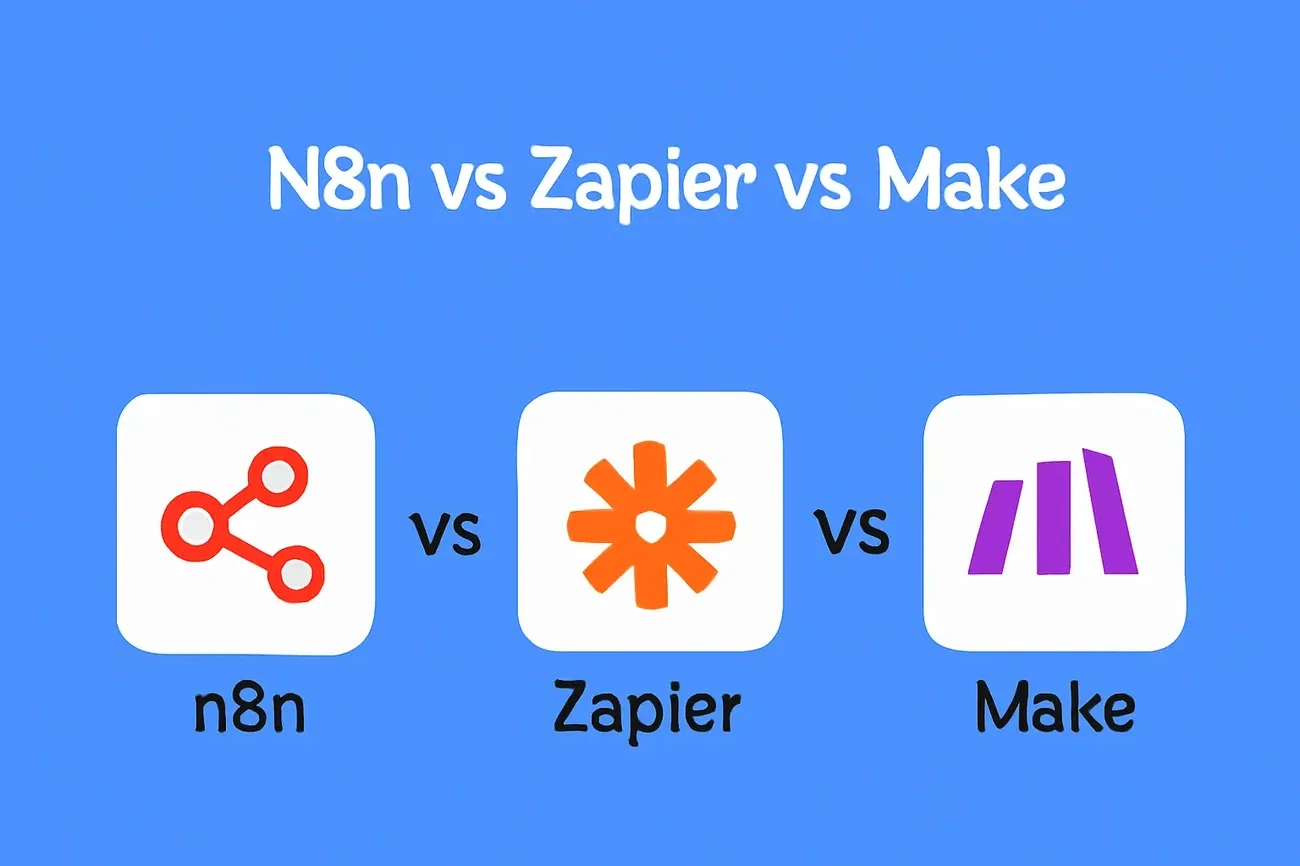Do you need to automate your business processes but don’t know which tool to choose? The comparison between n8n and Make will show you two completely different approaches to connecting your business applications. n8n stands out as an open-source, self-hosted alternative to Make (formerly Integromat), offering impressive flexibility for advanced workflows.
Make has been established with over 2,000 native integrations and operates on multiple server zones with proven scalability. N8N, on the other hand, offers unparalleled value through its free self-hosting option and a unique pricing model that doesn’t charge extra for complex workflows with many operations. With plans starting at €20 per month for 2,500 workflow runs, n8n Cloud provides an affordable entry point for businesses of all sizes.
What makes both platforms particularly exciting today is their AI integration capabilities. n8n has built-in functionality to connect AI models like GPT-4 with various tools, enabling intelligent automation with decision-making. Plus, with over 2,400 out-of-the-box integrations, you can connect CRM systems, spreadsheets, marketing tools, and more without manually setting up APIs .
In this guide, you’ll learn exactly how these platforms compare in user experience, technical capabilities, AI features, pricing, and scalability. By the end, you’ll have all the information you need to choose the right automation tool for your specific needs.
Key Points Comparison N8N vs Make
This comprehensive comparison reveals two distinct automation philosophies: n8n’s technical flexibility vs. Make’s user-friendly approach. Here are the essential points to guide your choice of platform:
• Choose n8n for more technical control: Open-source platform that offers unlimited self-hosting, JavaScript/Python programming capabilities, and pricing based on running workflows rather than individual operations.
• Select Make for ease of use: Cloud SaaS that provides an intuitive drag-and-drop interface, over 2,000 native integrations, and predefined features perfect for non-technical users.
• Carefully consider long-term costs: n8n becomes significantly cheaper at scale (€305 vs. €7,252 for 9.5 million operations), while Make offers lower upfront costs for simple automations.
• Strategically assess AI needs: n8n offers advanced AI agents with RAG capabilities for complex decision-making, while Make provides accessible AI modules for basic tasks such as classification and summarization.
• Consider the investment in learning: n8n requires several weeks to master but rewards with unlimited customization, while Make allows you to reach a basic level of proficiency in a few days through guided tutorials.
Ultimately, the choice depends on your team’s technical expertise, data sensitivity requirements, and long-term scalability needs. Both platforms offer free trials, making it possible to see which approach aligns best with your specific automation goals.
Overview: What are n8n and Make?
Image Source: Digidop
n8n and Make represent two completely different philosophies in the world of workflow automation. Both platforms connect enterprise applications, but their approach and methodology differ radically.
Origin and philosophy of each platform
N8N appeared in 2019 as an open-source automation tool that uses a node-based interface. Its core philosophy focuses on technical flexibility and advanced customization. The platform has achieved more than 66,000 stars on GitHub and has a community of more than 55,000 members as of March 2025, demonstrating its adoption among technical teams.
Make (formerly known as Integromat) has been operating since 2016 and has established itself as a SaaS platform focused on ease of use. Its philosophy prioritizes the intuitive visual experience through “scenarios” that clearly show the flow of data between applications. The platform is designed specifically for users with no technical experience, offering a colorful drag-and-drop interface.
Key Differences in Approach: Open Source vs SaaS
The most significant difference between the two platforms lies in their implementation model:
N8N as an open source solution:
- Allows self-hosting on own servers
- Ensures full control over data and security
- Especially valuable for organizations with strict compliance requirements
Make as a service exclusively in the cloud:
- Offers managed infrastructure
- Provides GDPR compliance and SOC2 Type II certification
- Includes 24/7 premium support
- Eliminates the need to manage servers, but limits control over data residency
Typical use cases for each tool
The choice between n8n and Make depends mainly on your technical and organizational needs:
N8N is best suited to:
- Technically savvy teams looking for total freedom
- Organizations that handle sensitive data or have specific security requirements
- Projects that need scalability without excessive costs due to volume of operations
Make is ideal for:
- Non-technical users who need to automate tasks quickly
- Marketers and entrepreneurs looking to connect apps without writing code
- Scenarios that require a highly intuitive visual interface
Remember that both platforms allow you to synchronize data between applications, send automated emails, or manage complex business processes. The fundamental difference is in the approach and the ideal user for each one.
Interface and User Experience
Image Source: Digidop
How easy is it to create your first automation? The interface you use every day determines whether you’re going to feel comfortable or frustrated with your automation tool. Here’s the key differences between n8n and Make so you understand what to expect from each platform.
Visual Editor: Workflow in Make vs Nodes in n8n
Make uses a canvas-like interface with a colorful and intuitive design where each automation (called a “stage”) is visualized through interconnected modules. You can easily drag and drop elements, getting a clear representation of the data flow. Its interface is designed to be accessible even if you’ve never coded before, with simplified mapping using drop-downs that don’t require code.
n8n adopts a node-based system similar to development tools such as Node-RED. When you access n8n, you’re met with a simple canvas with nodes that represent services, triggers, or workflow logic. While this structure may seem more technical at first, it gives you exceptional flexibility and control over every step of the process.
Learning Curve: Beginners vs Technical Users
Make is optimized for users with no coding experience, with a moderate learning curve that allows you to reach basic proficiency in a few days. Its guided experience includes onboarding tutorials, tooltips, and an intuitive interface that lets you automate processes in minutes.
N8N features a steeper curve, especially if you don’t have technical experience. Fully mastering the platform may take several weeks. However, this initial investment of time offers you long-term rewards when you’re looking for flexibility and advanced control.
Testing and debugging: tools available on each platform
The testing and debugging capabilities reflect completely different approaches:
Make gives you a simple but manual approach to debugging:
- Execution by modules or complete step-by-step scenarios
- Error handling individually configured for each module
- Organized logs that show you exactly what data travels through each connection
N8N gives you more advanced tools:
- Anchored and simulated data that allows you to test specific parts of the flow
- Global error triggers that capture issues from all automations
- Detailed logs and stack traces for fast and accurate diagnosis
This difference in debugging tools can prove crucial when your automations grow in complexity or are critical to critical business processes.
Technical capabilities and customization
Image Source: Jpadweb
When you analyze the technical capabilities of these platforms, you discover differences that can determine the success of your most complex automations . The customization available in each tool often defines which one best suits your specific needs.
What level of code can you use on each platform?
N8N gives you complete flexibility through direct code. Its Code node allows you to write JavaScript or Python for advanced data transformations and custom logic. This capability is especially valuable when you need to manipulate information in ways that standard features don’t cover. In addition, the n8n expression editor uses native JavaScript for common array and string operations.
Make takes a different approach focused on predefined functions. Its library includes out-of-the-box operations such as date formatting, mathematical calculations, and text modifications. This strategy eliminates the need for programming, allowing you to perform complex tasks by selecting options from drop-down menus.
How They Handle Errors: Centralized vs. Individual Systems
Error handling reveals another key distinction between the two platforms:
N8N implements a global system using specific error workflows. When you create a workflow with the Error Trigger node, you can designate it as an error handler for multiple automations. This centralized approach simplifies fault management and enables consistent responses to problems.
Make requires individual bug configuration for each module. While this method is more labor-intensive for complex automations, it gives you granular control over how failures are handled in different parts of the process.
Flow control: loops, waits and intelligent routing
Flow control shows the most practical differences between the two tools:
N8n excels in:
- Merging paths that link multiple data paths
- Robust loops for repetitive tasks
- Extended waits that can pause flows for days or weeks
Make excels with:
- Routers that split a flow into multiple paths based on specific conditions
- Visual management of different scenarios within the same automation
Remember that while Make limits wait times to 300 seconds (5 minutes), n8n allows for much longer pauses, ideal for processes that require tracking for extended periods. This difference is crucial for automations that span days or weeks, such as customer follow-ups or regular check-ins.
AI Automation: n8n vs Make
Image Source: AI Rockstars
AI integration is reshaping how we think about workflow automation. Both n8n and Make have built AI capabilities into their platforms, though they take fundamentally different approaches that reflect their core philosophies.
AI Agents in n8n: autonomous decisions and RAG
You’ll find that AI Agents in n8n work as autonomous workflows that make decisions, interact with applications, and execute tasks without constant human intervention. These agents use a combination of memory, goals, and tools (like web search or database access) to reason step by step through complex tasks.
n8n stands out with its RAG (Retrieval Augmented Generation) implementation, which allows agents to:
- Retrieve real-time information from documents, wikis, or internal data
- Generate updated and verified content with greater accuracy
The platform allows you to anchor AI in predictable logic, mixing deterministic automation steps with AI to increase reliability and add human approvals when needed.
AI Tools in Make: classification, summarization, translation
Make offers a more accessible approach through predefined, ready-to-use AI modules. Its main capabilities include:
- Pattern detection and tracking in data
- Automatic information summarization
- Intelligent decision making and data enrichment
- Automatic classification and request routing
Make focuses on simplicity, allowing users without technical experience to incorporate AI into their workflows. Its interface facilitates automatic content generation and publishing when new records are created.
Limitations and advantages of each approach
n8n offers greater customization and power, but requires more technical knowledge. Its advantages include:
- Complete control over AI agents through predefined logic
- Capability to implement complex RAG systems
- Advanced monitoring tools with logs and visual workflows
However, AI agents can “hallucinate” and make errors that are difficult to control, as they respond differently to each individual request.
Make provides a more accessible experience with AI-based automation that adapts to business processes. Its limitations include:
- Less flexibility for deep customization
- Difficulty implementing multi-agent systems or complex AI chaining
Remember that it’s generally advisable to avoid using AI when you can automate a workflow traditionally to make it more reliable and cost-effective, since each AI request generates additional costs.
Pricing, scalability, and hosting
How much will it really cost you to automate your processes? Cost and scalability determine the long-term success of any automation solution. Here, you’ll find out which pricing model best suits your specific situation.
Pricing model: per execution vs per trade
n8n and Make use completely different billing strategies that directly affect your budget:
- n8n: Charges for full workflow execution, regardless of the number of steps
- Make: Invoice per individual transaction within the flow (each module counts as one transaction)
This difference is crucial depending on the type of automation you need. For processes that don’t run frequently but process large volumes of data, n8n is usually cheaper. However, for automations that are constantly activated but with few actions per execution, Make can offer better value for money.
Self-Hosting Options at n8n
n8n stands out for offering a completely free Community Edition for self-hosting with no limits on executions or main functions. Available options include:
- Installation via npm or Docker on your own servers
- Deployment on providers such as DigitalOcean (approximately €5/month)
- Services like Render or Railway for quick start
Remember that self-hosting provides full control over data and security, although it requires technical knowledge for configuration and maintenance.
Scalability and long-term costs
For massive volumes, the cost differences widen considerably:
- A real case documented 9.5 million monthly operations with n8n for €305.35, while the equivalent cost in Make would have exceeded €7,252
- Make is economical initially (plans from €8.59/month for 10,000 operations), but costs increase quickly with complex scenarios
It’s important to consider that n8n Cloud starts at €20/month for 2,500 runs, but its model favors complex workflows by not charging extra for additional operations within each run.
If you’re going to process large volumes of data or create complex automations, we recommend carefully evaluating these pricing models before making your final decision.
Comparison Table: n8n vs Make
Here’s a detailed comparison of the main features of both platforms. This table will help you evaluate which tool best suits your specific automation needs:
| Feature | n8n | Make |
|---|---|---|
| Platform Type | Open source, self-hosting | Cloud-based SaaS |
| Year of Release | 2019 | 2016 |
| Native Integrations | +2,400 | +2,000 |
| Code | JavaScript/Python support via Code | Predefined functions only |
| Error Handling | Global error | Configuration module by module |
| Pricing Model | Per workflow | Per individual operation |
| Starting Price | €20/month (2,500 runs) | €8.59/month (10,000 trades) |
| Self-Hosting | Yes (Free Community Edition) | No |
| Waiting Times | Extended waits possible (days/weeks) | Limited to 300 seconds |
| AI | Advanced AI Agents, RAG | Predefined AI modules for basic tasks |
| Learning Curve | More pronounced, several weeks to master | Moderate, few days for basics |
| Target Users | Technical teams, developers | Non-technical users, marketers |
| Interface Type | Node-based | Visual drag-and-drop scenarios |
| Community | +55,000 members, +66,000 GitHub | Unspecified |
| Safety | Unspecified | SOC2 Type II, GDPR compliance |
Remember that this comparison provides you with an overview of the key differences. The final choice will depend on your technical resources, budget, and specific automation goals.
Conclusion
Which is the best option for your company? The decision between n8n and Make depends fundamentally on your specific priorities and the technical level of your team.
If you’re technically savvy and value full control over your data, n8n will give you the flexibility you need. Its free self-hosting capability and per-run pricing model makes it the most economical choice for complex workflows. We recommend n8n especially if you handle sensitive information or need scalability without prohibitive costs.
For marketers, entrepreneurs, and teams looking for quick results with no technical complications, Make offers the simplicity you need. Its intuitive interface will allow you to automate processes in a matter of minutes, although you should consider that costs can increase significantly with complex automations.
From an economic perspective, remember that n8n is generally more cost-effective for processes with many operations, while Make can be more economical for simple automations with frequent activation.
In terms of AI, both platforms offer intelligent capabilities, but n8n provides more advanced options if you need autonomous agents or complex RAG systems.
Our advice is simple: take advantage of the free trials of both platforms. This will allow you to assess which one best suits your way of working and the specific needs of your organization. Investing initial time in this assessment will save you additional trouble and costs in the long run.
Need help deciding? First consider the technical level of your team, the volume of automations you plan to create, and your available budget. With these factors clear, the choice becomes much simpler. Remember that at Verificaremails we have AI Agent templates with N8N so that you can deploy them in minutes in your environment and automate routine tasks that will take you more than 10 hours of work a week.
FAQs
Q1. What’s the main difference between n8n and Make in terms of approach?
n8n is an open-source platform that offers greater technical flexibility and control, while Make is a cloud SaaS solution designed to be easier to use for non-technical users.
Q2. How do n8n and Make’s pricing models compare?
n8n charges for full workflow execution, regardless of the number of steps, while Make bills for each individual operation within the flow.
Q3. Which platform is best for AI integration in automations?
n8n offers more advanced AI capabilities, such as autonomous agents and RAG, while Make provides more accessible predefined AI modules for basic tasks such as classification and summarization.
Q4. What is the learning curve for each platform?
Make has a moderate learning curve, allowing you to reach basic proficiency in a few days. N8N has a steeper curve, which may require several weeks to fully master the platform.
Q5. Which platform is most economical in the long run for large-scale automations?
For massive volumes of trades, n8n is generally cheaper. A real case documented 9.5 million monthly operations with n8n for €305.35, while the equivalent cost in Make would have exceeded €7,252.








